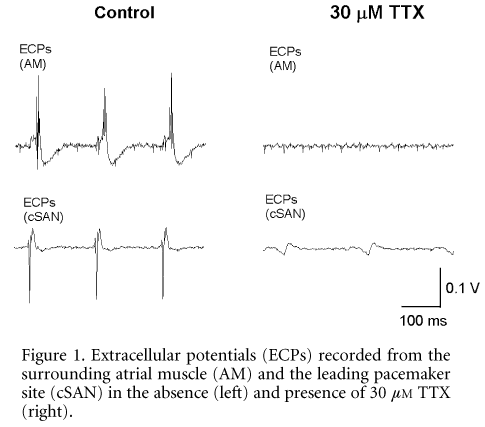A very interesting question is what mechanisms underlie the remarkably fast murine sino-atrial node (SAN) beating rates of 350-600 beats min-1. We recently reported that fast sodium current, iNa, contributes to pacemaking of isolated murine SAN cells (Lei et al. 2002). To further elucidate the role of iNa in murine SAN pacemaking, we have studied the effect of TTX, a selective iNa blocker, on the electrical activities of intact murine SAN.
Hearts were excised from 20-25 g adult C57BL mice after Schedule 1 killing by cervical dislocation. After dissection of SAN and some surrounding atrial muscle, the preparation (endocardial surface up) was fixed in a tissue bath and was superfused with Tyrode solution at 35 °C at a rate of 4-5 ml min-1 through a heat exchanger. Extracellular potentials (ECPs) were recorded as described by Yamamoto et al. (1998). ECPs in and around the SAN under control conditions showed a variety of morphologies. The activation pattern was similar to that reported from rabbit SAN (Yamamoto et al. 1998). Spontaneously beating SAN tissue was superfused with 1-30 µM TTX. In 6 out 6 preparations, up to 5 µM TTX caused 3:1 or 2:1 sinus-atrial (SA) conduction block and 30 µM TTX caused a complete block of SA conduction. 30 µM TTX also terminated the pacemaker activity of the peripheral region and decreased pacemaker beating rate of the leading pacemaker site by 19 ± 4 % (n = 6, P < 0.01, Student’s paired t test). Figure 1 shows an example of the effect of TTX on the electrical activities of the surrounding atrial muscle and the leading pacemaking site.
The results suggest that iNa is of importance for maintenance of physiological pacemaking and its role is greater in the periphery than in the centre.
The work was supported by The Wellcome Trust.
All procedures accord with current UK legislation.

